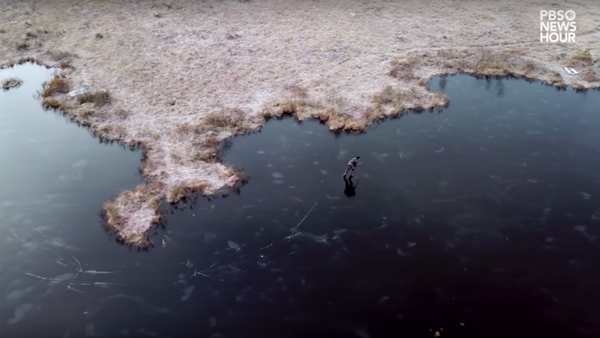Stepping onto an inch-and-a-half thick piece of lake ice—much less doing laps on it—is a no-go for most people. But for experienced Swedish skaters Henrik Trygg and Mårten Ajne, few things top skating on thin ice.
In December, still photographer Trygg filmed Ajne skating on 1.8 inches of fresh ice on a lake outside Stockholm. The resulting mini-documentary— filled with the eerie, laser-like sounds of bending ice—went viral in February.
One shot shows the ice, commonly called “black ice,” visibly bending under the skater’s weight. Which raised the question: Why doesn’t this thin frozen surface break?
On supporting science journalism
If you're enjoying this article, consider supporting our award-winning journalism by subscribing. By purchasing a subscription you are helping to ensure the future of impactful stories about the discoveries and ideas shaping our world today.
For the answer, we turned to Ajne, a 35-year veteran of nordic skating whose day job is calculating risk. He is a mathematician and actuary at a consulting firm.
Ajne explained that while skaters call the surface black ice, it is actually congelation ice, also known as columnar ice or “Kärnis” in Swedish.
The term black ice is different from the hazardous ice slicks on roads and bridges in the U.S. that bear the same name.
In both cases, black ice in a misnomer, as the surfaces are actually transparent. Black ice on roads, which takes on the color of the pavement below it, forms when precipitation freezes on impact or melted runoff refreezes.
Congelation ice, on the other hand, grows downward from the surface of a calm lake when temperatures are sufficiently cold. The crystals develop slowly in a vertical, column-like fashion with horizontal interlocking grains. Unlike “snow ice,” which forms when melting snow refreezes on an existing ice surface, congelation ice contains very few bubbles. The result is a strong, but nearly clear sheet of ice.
“It looks black as the water beneath absorbs all light,” Ajne said. “Over shallow waters, it is possible to see the bottom, creating a [vertigo-inducing] sensation.”
Congelation ice, while a solid form of water, does bend slightly and acts like an elastic plate buoyed by the water below. To Ajne, it’s Archimedes buoyancy principle in action.
“A body partially immersed in water is buoyed by a force equal to the weight of the water displaced by the body,” he said.
Skating on congelation ice does still cause cracks. But the amazing thing, Ajne said, is that the ice doesn’t come apart.
“Three-dimensional stress-distribution prevents the ice-cover to break. [It is] the same principle as for an arch or a dome,” Ajne said. The skater’s weight causes the ice to bend, like an arch. Even if a crack forms, compressive forces from the surrounding ice laterally pushes the separation together.
But when black ice is thinner than 1.25 inches, cracks in the central part of the arch can no longer be supported vertically or horizontally. For practical purposes, Ajne—who has fallen through ice close to a hundred times—believes amateur skaters can consider two inches of black ice safe. “This gives a safety margin, both for the ice and human mistakes,” he said.
Even when congelation ice appears thick enough, Ajne recommends skaters use good judgement and have at least one partner when venturing out. He emphasizes anyone trying the feat should carry a flotation device, ice claws, an ice pole and a rescue line with a carabiner. A change of clothes in a water-tight bag are also important in case of a fall through the ice.
Ajne assessed thousands of incidents where skaters fell through the ice and determined most are trivial. “It’s more like a damp interruption to skating … [They] fall in, climb out, change clothes and continue. Skaters don’t consider them accidents at all. It’s a natural part of Nordic skating,” he said.
Most skating accident deaths, Ajne said, occur when the safety measures are not followed. In a country where skating is practically a national pastime, only three deaths in the past century occurred when all safety precautions were followed.
This article is reprinted with permission from PBS NewsHour. It was first published on March 9, 2018.
